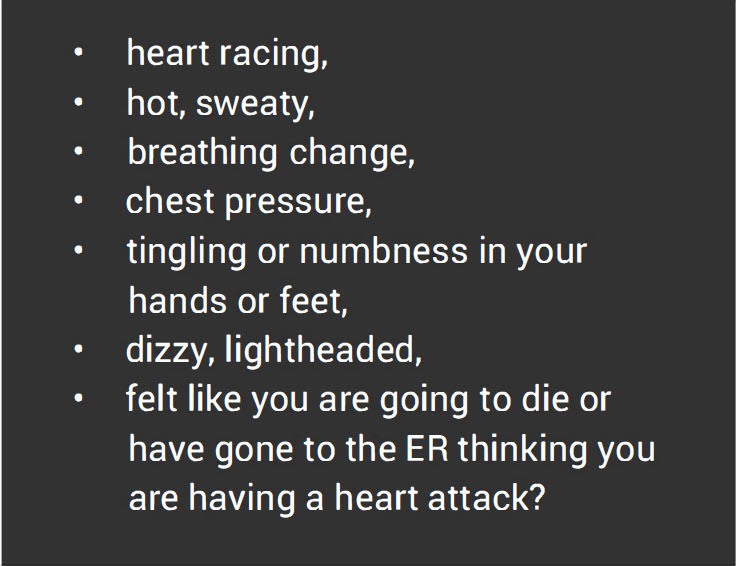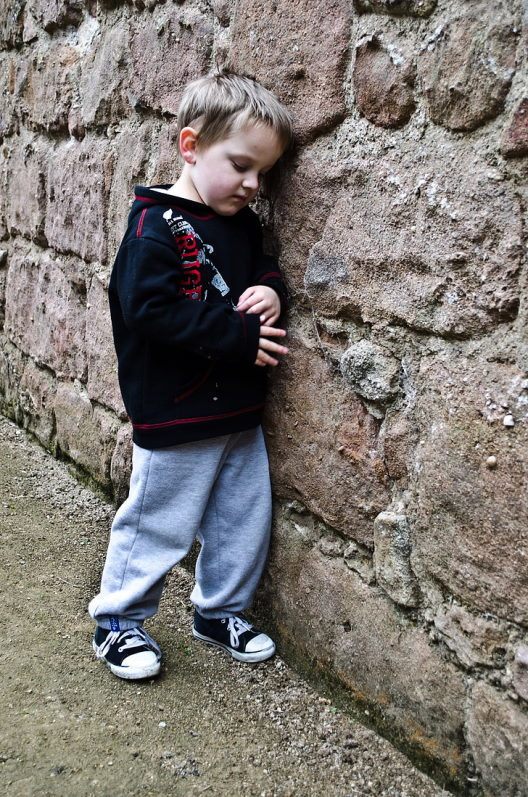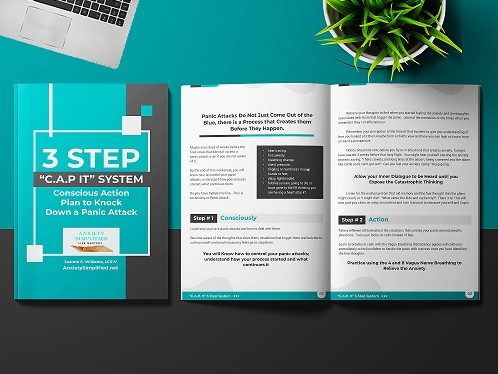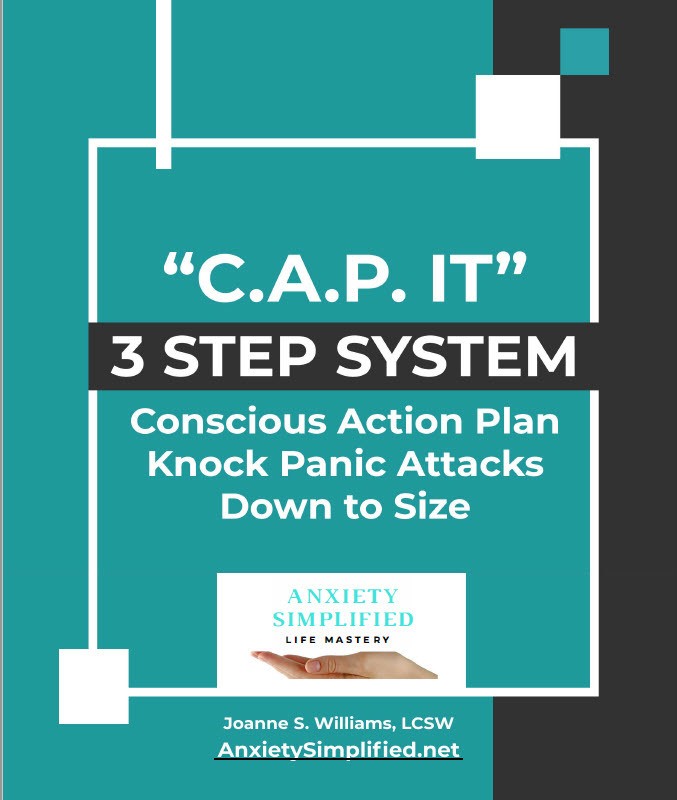Conquer Panic and Anxiety Attacks in Children or Teens with this Free Worksheet
This 3 steps “CAP it” Conscious Action Plan Worksheet is designed to show you how to knock out panic attacks with your kids and teens. You will be able to identify and know how to conquer panic attacks in 3 simple steps without having to avoid places that create fear.
You may think that you or your child are never going to understand or even know how to deal with anxiety or panic attacks that seem to come out of the blue. You may only work 1 hour per week with the therapist, but you are left the rest of the week to deal with it yourself.
This is your guide and blueprint that you can use anytime and anywhere to immediately know what to do, be a role model to teach your panicky child how to feel in control of their own anxiety progress by intervening to "Cap it".
The Panic workbook helps me separate facts from feelings to knowing where these old feelings and are coming from that create the anxiety and panic to manage my responses better.
Jenny M.
Industrial designer

Panic or Anxiety Attacks in Children
Panic or Anxiety Attacks in Kids at Night
Do panic attacks seem like a big mystery and are unsolvable or that panic attacks just come out of the blue? I want to reassure you there is a process that creates them before they happen. Sometimes they start days or weeks before they blow up into an anxiety or panic attack.
Let’s take the mystery out of them to reassure you that there is a progression that happens from a trigger, that once you can identify it, you can Conquer this pattern.
This is your guide that you can use anytime and anywhere to immediately know what to do, and you can be a role model to your child or teach your panicky child what to do.

I am Joanne S. Williams, LCSW, a 30-year veteran Licensed Mental Health Professional. I counsel clients who struggle with anxiety to shift their focus from fear to fulfillment to achieve their greatest potential and this free worksheet is designed to do just that for you.
Let’s talk facts first and then what you can do about them.
Panic attack in kids is a Surge of intense fear and discomfort that peaks within minutes and these are the symptoms:
- Racing heart,
- Hot or cold sensation,
- Sweaty, clammy palms
- Breathing quickens or feel short of breath
- Chest pressure, or pain
- Tingling or numbness in your hands, feet, or lips
- Dizzy, lightheaded, or faint
- Dissociated or detached from reality
- Feel like you are going to die or have gone to the ER thinking you are having a heart attack and they told you are having an anxiety attack.

Panic Attacks are not dangerous and won't’ kill you, but the symptoms can feel like they might. A memory or a situation can trigger a terror or fear response that has been avoided. Because it reminds you of that potential danger.
Only four of these symptoms are needed to be diagnosed as a panic attack from the DSM-5, The Diagnostic Manual for Psychological disorders used by a Professional to diagnose different psychological symptoms. I will be using panic and anxiety attacks interchangeably since, clinically we consider them the same.
Child Panic Attacks at Night
Panic affects about 6 million adults in the U.S. Women are twice as likely as men to develop the condition, and its symptoms usually begin in early adulthood. Only 1-2 % of children under 12 yr. or 2-3 % adolescents. Remembering that uncertainty and fears are driving this.
Giving reassurance and logic that the person is not dying, because they are having a fear reaction or feeling out of control or overwhelmed. They can learn the skills of how to handle their anxiety.
Some ask why these happen at night or at rest. As I explain to clients, our brain and body are so well designed that even as we sleep, we are processing data from the day and organizing it and storing it away to use later.
You may have been involved in an incident 1 week ago that is still stressing you or you fear a trip in 2 weeks, your brain is processing this fear at night or when you relax. While your mind is less busy. It can show you what is creating your stress. It can help you be more conscious of what is creating the stress or anxiety, to help you understand how to let it go. Or it gets stored back again for you to deal with later.
If you or your child has these more severe symptoms you will need to speak to a professional. Knowing that avoidance is the key defense or using magical thinking or in a child they can get very agitated or angry or sad, not having the words to describe it.
There are steps and a progression that build up before they happen, maybe even days of weeks before the final straw that blows it up into a panic attack, even if you are not aware that that Is happening.

Panic Disorder in Children
If you are asking your child or teen about them, they may not know or be aware of these symptoms. Part of the plan is for them to know their triggers and what make them progress. So they can become aware of them to intervene before they progress into a panic attack.
A younger child may get angry and defensive to protect themselves, since under the age of 12, their brain has not developed the logic or ability to understand or figure out what is happening. It can feel like a real threat, and they don’t know how to deal with it.
I have treated clients over my 3 decades who struggle to understand what is going on in their body and their mind that cause the anxiety attacks that can leave you feeling helpless, defeated by them, thinking you are doomed to succumb to them and they’re unsolvable.
There is nothing further from the truth. You can learn why you have panic attacks and how to deal with them.
What your thoughts are focused on, are the biggest indicator of relief from panic or the continuation to a panic attack, when you continue to focus on imagined fear that started them or giving yourself reassurance.
The child’s thoughts they are reacting to, are not happening right now, they feel like they are and 99 % of the thoughts in a panic attack never come true? They are thinking of the worst case scenario of the situation.
Joanne Williams has develop a free worksheet of How to Conquer Panic Attacks with 3 steps “CAP it” Conscious Action Plan at AnxietySimplified.net
I you want the full 3 video course designed to show you how to knock out panic attacks with your kids and teens. You will be able to identify why and know when panic occurs and how to conquer panic attacks in 3 simple steps without having to avoid places that create fear.
These are skills, not pills...
This worksheet can give you Panic Relief:
Step 1:
Consciously- become aware of the thoughts that drive your anxiety progress into a panic attack.
Name the situations that trigger the fear, flying, social situations, crowds and then follow it back to when you started to think about the worst-case scenario might happen.
Step 2:
Action using the miracle breathing technique often and if you even start to feel the anxiety rising, you can do anywhere and anytime that will calm you immediately Guaranteed by science research.
Learn to breathe in the calm with the Vagus 4-8 Breathing that Science agrees will calm you immediately that works immediately to feel confident to handle the fearful situation. You can see Vagus Nerve Podcast video at AnxietySimplified.net 7 ways to Go from fight-or-flight into rest-and-digest within minutes told by scientists Podcast #46.
Step 3:
Plan-Take a different perspective about the situations that created your panic previously in your specific situations by using your logic in the moment to assess the currently situations to send reassuring thoughts that you can handle this situation now
a. Train your brain to focus on calm and reassurance instead of the imagined fear.
b. Refocus fear thoughts to reassurance, breathe to calm, refocus on encouraging thoughts and learn to sit with the fear and watch it melt away with a calming visualization.
You can learn to tell a new story-without fear or catastrophic thinking.
Have you child become their own superhero? Imagine the fearful situation in a panic attack, turn it around to imagine your hero swooping in to take out the fearful boogie man in the situation.
Become Cautious of the old stories we tell ourselves “The woe is me” The “Trauma drama” stories we tell others of who we are and how life has treated us, that don’t serve you anymore.
Reorganize your perspective, to what will and can happen when refocused with a calm intention and a new attitude of open mindset to know you can “CAP” your panic attacks.
As the parent you can help your teen or child understand it is not real and how to become aware of the emotional triggers and thought process that will help them to deal with a panic attack in the day or nighttime.
Especially using the breathing technique in step 2, use this first or immediately, when their panic attacks happen and help them to use this before they get stronger, before a full-blown panic attack.
You can also use these techniques for nightmares. Reassurance is the key here.
As the parent, the child or teen can feel whether you know what to do and how to help them. This guide will help you to know steps to use to help them feel in control.
If you are unable to do this yourself. Bring the workbook or the worksheet to your therapist for additional help.
You can ask the child more about what you are observing in their emotional response or their behaviors. You can say, “You look angry”. What has made you angry. “That is an emotion that helps us say no to someone”. “Did someone not respect you saying NO to them or hurt you in some way?”
Or “you look sad or scared”, “can you draw me a picture of what is making you so sad or scared?” As an example of a way to help them figure out what is bothering them. Because they genuinely may not know what is wrong and asking them what is wrong, can add more confusion or pressure that creates more anxiety for them.
If they share that someone threatened them with serious bodily harm or sexual violence, they need help from adults and professionals to figure out what to do and if Post Traumatic Stress Disorder is happening to them.
This is not covered here but will need a professionals help from your doctor or therapist to help you and your child understand better what happened to them or their perception of what happened, since this can have long term effects on them. The most common way is to just avoid it completely and is the number one symptom in PTSD.
Look at changes in mood or behaviors and speak to what you are observing. This is one of the best ways to start a conversation.
Or speak to their teachers, or coaches to get outside confirmation of these changes. And then you can take the necessary steps to protect your child and get the appropriate treatment for them and your family.
This rarely happens without external influences causing this kind of extreme response. Early treatment has the best outcomes.
Learning skills to address anxiety, panic and other emotional issues can be learned, just like any skill. Use this worksheet as your guide or seek professional help from a licensed therapist where they can teach these skills as well.
So, invest in these and other life lessons to learn the skills needed to overcome panic attacks in your child and teens with the 3 Step Cap it System.
Or if an emotional support animal to be with them in housing or a Psychiatric Service Dog to go where they go could helpful, please reach out for help. See how to qualify at EsaPros.com
Since 1995 Joanne has guided client’s transformation from fear to fulfillment, to live more fully in their lives. Whether clients are engaged in private sessions or getting certified to have an Emotional Support Animal to live with them or a Psychiatric Service Dog to fly with them, they welcome life changing results.
As the Host of 'Anxiety Simplified' Podcast Joanne offers simple but effective strategies for everyday life solutions.
Joanne is one of the authors in Raising the Bar on Amazon Bye Bye Panic, Hello Calm and Confident on her “Cap it” 3 step system to Conquer Panic Attacks.
3 video course that includes an inclusive journal of How to Conquer Panic Attacks is available HereMore Information About the Conquer Your Panic Attack Course
The "Cap it" System teaches skills that can be used for life in different emotional situations to refocus from fear to reassurance. The Course is a step by step guide exactly what you need to do. The workbook Journals the triggers, the when, where and how come they happen. Gives you a demonstration of the miracle breathing technique that 100% of my clients that have practiced it feel calmed by it, since you will know how to send a calming chemical naturally into your body. Be able to change your perspective about the previously anxious situation to switch it to a logical way to manage the anxiety.
Kids and teen will get this quickly
Kids are used to telling stories and can change the ending to this scary story that lead to a panic attack, that they HAD been telling themselves into a story they can control now.
Use this for night terror or nightmares
This is a process that you can reuse over and over again to give reassurance to a child once you as the Adult understand it. It will reassure you as well.
Feeling in control where panic was
When scary things happen in our life, we continue to recreate them to keep us safe. Having these tools can replace scary by recreating a way to control the fear, once and for all.

Using the 3 step Panic Plan helped me to understand my anxiety process and see when it starts. Then I could show my son. I didn't think I could do this myself, but, I have done it and it works. Now my son and I both use it and we help remind each other to breath and focus.
Julia H. ‧ Hair Stylist

I have a tough job as a parole officer and go into places no one wants to go into, I have used the breathing techniques in situations that used to terrify me, and now I can calm myself immediately.
Jan P. ‧ Parole Officer

Stop Panic Attacks Now
This course is video based to be able to re listen to over and over again with a workbook to follow again or reuse you conquer one trigger you can see your progress to feel you can do this!

